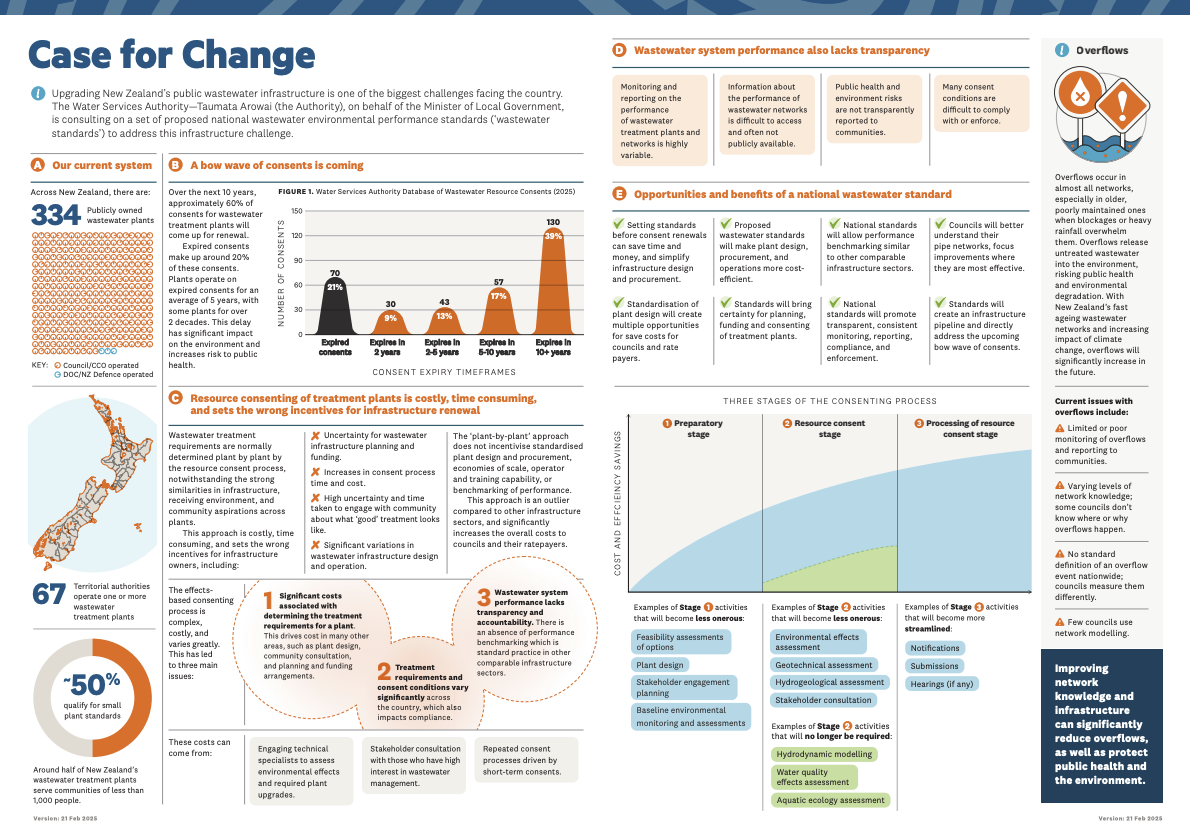New Zealand's Water Management Issues
Regulatory Framework
Until February 19, 2025, New Zealand did not have water standards
By September 2025, all councils must submit plans to Taumata Arowai (the wastewater regulator ) on how they will meet new compliance requirements
60% of council wastewater treatment plant consents will expire within the next 2-5 years, requiring new solutions
Current Infrastructure Problems
NZ has 334 wastewater treatment plants across the country
Most rely on passive "settling ponds" systems that won't meet new standards
Active treatment systems require significant energy, but NZ's energy supply is already constrained
45% of emissions from wastewater treatment come from disposal and energy consumption
Examples of current issues:
Auckland: Sends sludge to Puketutu Island (offensive to Mana Whenua)
Wellington has been landfilling its sludge
Queenstown: Sends untreated sewage into the Shotover River, which feeds into Lake Wakatipu
Alimentary Systems' Solution
Uses biomethanation/anaerobic digestion + thermal hydrolysis in a new method to recover 4- 10X more energy from sludge than current methods
This energy can power wastewater treatment plants.
Co-digestion with other organic waste (food waste, grape marc, DAF sludge, fish waste) produces more energy than is needed to run the plant
Blending C:N ratios instead of denitrifying ponds reduces costs below the current council disposal methods
Provides better environmental outcomes:
No waste to landfill
No methane emissions
Reduces nitrous oxide emissions
Potential to produce fertilizer at 2/3 the cost of the synthetic alternative
Scale of the Current Issue
- 21% of New Zealand's 334 wastewater treatment plants are currently operating with expired consents
- Another 30 plants will have consents expire within 2 years
- 43 more plants will have consents expiries in 2-5 years
- 57 additional plants will have consents expire in 5-10 years
- In total, 60% of plants will require upgrades within the next decade to meet regulatory requirements

Proposed Standards Framework
- Different standards for discharges to water versus discharges to land
- Inclusion of beneficial reuse of biosolids standards
- Standards for overflow and bypass arrangements during emergencies
- Coverage of discharges to land, air, water, biosolids, energy use, and trade waste
Technical Parameters
- CBOD (Carbonaceous Biological Oxygen Demand): 15mg/L standard
- Total Nitrogen: 10mg/L for lakes/wetlands, 5mg/L for rivers/streams (varies by dilution levels)
- Ammoniacal Nitrogen: separate standard of 3mg/L (90th percentile annual)
- E. coli standards vary significantly based on discharge location and dilution levels
- Compliance metrics based on 90th percentile measurements (allows non-compliance up to 36 days/year)
Notable Exclusions
- Discharges to air from wastewater treatment plants (methane, nitrous oxide)
- Recycled wastewater for non-potable use
- Endocrine disruptors, heavy metals, and PFAS contaminants
- Private networks and on-site treatment systems (e.g., septic tanks)
Professional Opinion
Strengths of the Proposed Standards
- Establishes a baseline regulatory framework where none previously existed
- Creates infrastructure planning certainty for consent renewal processes
- Standardises plant design opportunities for cost savings
- Includes provisions for biosolids beneficial reuse
Concerns with the Proposed Standards
- Inconsistent Standards: Different standards for different discharge environments could create regulatory complexity and potential loopholes
- Measurement Issues: Using 90th percentile annual measurements allows for significant non-compliance periods (up to 36 days/year)
- Nitrogen Thresholds:
- The 10mg/L nitrogen limit is below WHO guidelines (11.6mg/L) but significantly higher than what environmental advocates like Dr. Mike Joy recommend (0.6mg/L)
- Separate limits for total nitrogen and ammoniacal nitrogen could result in combined nitrogen levels exceeding WHO guidelines
- Dilution Ambiguity: Terms like "low," "moderate," and "high" dilution for rivers and streams lack precise definitions, creating potential enforcement challenges
- Exclusion Gaps: Private networks and on-site treatment systems being excluded create significant regulatory loopholes
- Bypass Provisions: Standards for overflow and bypass arrangements could potentially be misused as workarounds rather than last-resort emergency measures
Opportunities for Improvement
- Standardise to a single strict standard across all discharge environments
- Define dilution levels with precise technical parameters
- Reduce or eliminate the 90th percentile compliance window
- Lower nitrogen thresholds to align with the best environmental science
- Include private networks and on-site systems in the regulatory framework
- Establish stricter criteria for bypass arrangements to prevent misuse
Market Implications
The standards create significant business opportunities in wastewater infrastructure upgrading. Approximately 200 treatment plants require upgrades within 5 years to meet regulatory compliance. This suggests substantial investment opportunities in renewable energy integration and biosolids management technologies to help wastewater treatment plants meet these new standards.